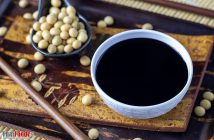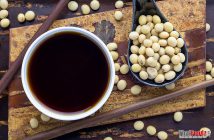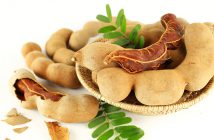The Thais use leaves and rind of the makrut lime in many dished to add citrus aroma and flavour. These are also used widely in Southeast Asia cuisine too.
Known in English as makrut lime or kaffir lime, but “kaffir” is disputed term and has some offensive meanings in many places. In Thailand, this plant is also called as มะกรูด (pronounce: Makrūd). Therefore, in this site, whenever I talk about it, I would favourably use the term of makrut lime.
Makrut lime is a citrus fruit native to tropical Southeast Asia, including Myanmar, Laos, Cambodia, Vietnam, Malaysia, Indonesia and Thailand. It is a thorny bush with distinctively shiny double leaves (looking like an hourglass) and bumpy fruit.
Makrut lime leaves
In Thai cuisine, the makrut lime leaves are the most frequently used part of the plant. There midribs are generally removed and then torn into large piece just before adding, probably at the beginnings – especially in making tom yum soups – or nearly final steps – like in making some curries and spicy stir-fried dishes – of cooking. In making the popular dish like panang curry, the makrut lime leaves are also essential ingredient added. Generally, the leaves are finely shredded and cooked to incorporate with other ingredients. This makes the panang curry has a distinctive aroma and flavour. The Thais also sometimes use these fine shreds to spread over many Thai dishes as edible garnish. This makes the dished look more enticing.
Makrut lime fruit
The juice and fruit of the makrut lime are less used in Thai cooking, but the rind is essentially used in most of Thai curry pastes. In making one of Thai famous curry called kaeng thepo, after finishing cooking, the fruit is halved and then added. This is to add more wonderful aroma and flavour to the dish.
Outside the Southeast Asia, the makrut lime leaves and fruit can be challenged to find. The dried leaves are often available in Asian markets. For the skin or the zest, if difficult to fine, substitute it with the rind of the regular lime. The leaves can be also substituted with fresh lemon or lime leaves too.





